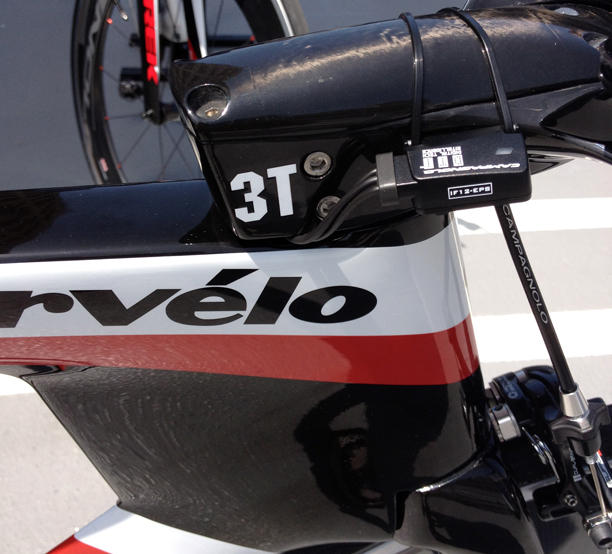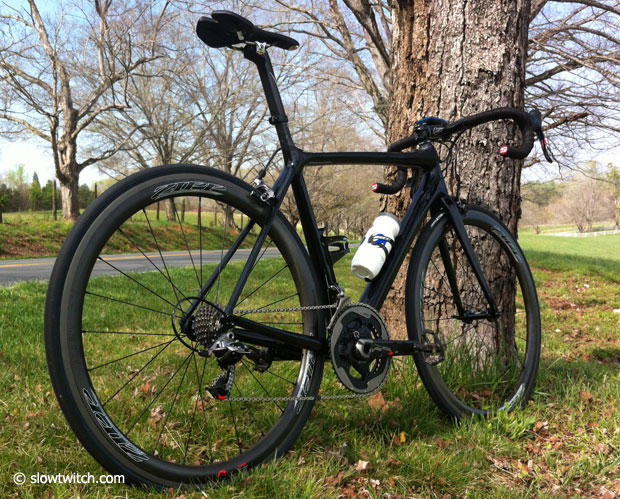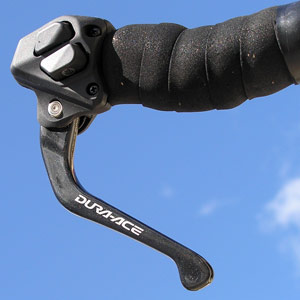Campy EPS for triathlon
Life, for the well-heeled triathlete, is about to get a little more complicated. Come September, 2012, some of you will have to make a new decision: Dura Ace Di2 or Campagnolo EPS (pics below) for your tri bike. While Shimano has a big head start in electronic shifting, Campagnolo just introduced the time trial version of its groupset. I rode it last week.
The EPS group I rode was hung a Trek Speed Concept, size L, set up to my fit configuration. Before writing about this group I felt it prudent to go back and again ride the same frame, same size, same config, equipped with a Dura Ace Di2 kit. Which I did. That having been accomplished, I feel I have a better idea about how these groups stack up.
Campagnolo's 10 Percent Advantage
First and most obvious is Campagnolo's extra gear. Its EPS system is 11-speed, versus Shimano's 10 speeds—until Shimano migrates soon-to-be-released 11-speed Dura Ace 9000, which is mechanical, over to its Di2 time trial group. As of this September, when EPS for TT is for sale, on a typical configuration, say, 11-25, it would look like this:
Shimano: 11,12,13,14,15,17,19,21,23,25
Campag: 11,12,13,14,15,16,17,19,21,23,25
That 16-tooth cog can come in handy.
But it's not necessarily advantage-Campy in cassette options. Shimano makes an 11-28 config, and Campy's 11-to-something tops out at 11-25. If you want a smaller gear for your Italian-made group you have to give up the 11-tooth cog, and go to, say, 12-29.
While there is no more storied company in high-end cycling, Campagnolo does not have a long tradition in triathlon. Bless its heart for realizing there's a match to be made with our higher-end demographic, even at this late date. But the master fabricators from Vicenza are still figuring out the fine details of our sport, one of which is that we do not—or at least we should not—stomp on the pedals when ascending, during a triathlon. Our effort needs to be more even, meaning close to the same power applied throughout the race, including during ascents. This may require a wide-range cogset, depending on the course and the area in which a triathlete lives. A 50×11 and 34×28 can both be course imperatives.
So why doesn't Campagnolo simply make an 11-28? Because it limits its cogset availability to what functions best while using its derailleurs. It simply doesn't think 11-28 shifts well enough, so, it doesn't make it. Fair enough. But this is exactly the debate in which Shimano found itself, during which time it lost business to SRAM for want of this feature. My 11-28 tantrum was published inside the body of a tech article I wrote in 2008 on choosing your correct chain length. What I wrote about Shimano four years ago is true for Campy now.
But I don't want to make too much out of this. Campagnolo makes its cranksets in either 110mm or 130mm bolt patterns, and you can pair a 53×39, 52×36, or 50×34 crank with 11-23, 11-25, 12-27 or 12-29 cogset. That's plenty of availability. Indeed, it seems not a problem for the rear derailleur cage—relatively short though it is—to handle 33 total teeth, i.e., 52×36 plus 12-29.
Shifting Speed and Performance
This may not make a lot of sense, but, what it feels like to me is that the Campy group shifts—as actuated by the rear deraillaur—slightly faster than the Shimano group. Perhaps the speed of the derailleur motor has something to do with this. Maybe it's the "brain" in the Campy system that delivers the message to the derailleur (more on that below). But on reflection I suspect it's because Campy has 11 cogs, so, the distance the derailleur needs to travel is 10 percent shorter.
This speed is offset, in my experience while riding both groups, by cogs that are not quite as chain-friendly as is the case in Shimano's high-end shift systems. When upshifting, you can hear the Campy chain contact multiple teeth before successfully lifting to the adjacent cog.
Nevertheless, with Campy EPS the shift happens very quickly, and it seems to me that the overall speed of shifting from one cog to another is pretty similar, Shimano-to-Campy. It's just a little noisier with Campy (which is uncharacteristic shifting for that fine brand).
Campagnolo offers one feature that continues a theme that runs throughout its groupsets. Whether ErgoPower or EPS, Campagnolo thinks that downshifting (and upshifting, but, especially downshifting) multiple cogs in a hurry, with one depression of a button, is important. And it's right. If you're going to host a crankset on your bike with a 16-tooth differential in chainrings—which is more and more common—then a shift from the big ring to the small is often accompanied by the need to move three cogs down, if you want to move to an adjacent gear (adjacent meaning, in this case, the next smallest gear in terms of gear-inches).
It's laborious to have to click a shifter three times to do that. Better to plunge that ErgoPower lever with your thumb (if on a road race bike). Likewise, if you hold the EPS button down when shifting up or down—in either the bar-end or pursuit position—EPS just keeps shifting. Bam bam bam. Nice feature.
Ergonomics
Campagnolo chose to use its mechanical bar-end shifter shape and functionality when designing its electronic group. On the one hand, this makes sense. If you get used to a certain motion for shifting, you don't need to learn a new one just for electronic. Instead of a button, it's a lever. Makes sense. Works well.
On the other hand, for taller UCI rule encumbered riders, who fall prey to the disliked 1.3.023 (BB to bar end), the return-to-center nature of the EPS shifters may mean that the 75cm (or 80cm with an ME) is measured to the end of the lever, rather than to the bolt affixing the lever to its base. This would make a Shimano-equipped electronic shift system solid to its end, and might make a difference to those who need all the solid and structural extension they can get.
One other ergonomic element of note is the spacing apart of the upshift and downshift buttons on the pursuit levers—as opposed to buttons adjacent to each other on Di2 pursuit levers. The idea is to differentiate between the buttons, so that when your IQ migrates down from 100 to 70 as the oxygen vacates your brain in favor of your thigh muscles, you can more easily remember which button is which. The downshift button is placed on the top of the pursuit lever, the upshift button on the inside of it.
Well, that's good. But each of these groups—Shimano and Campy—has the maddening consequence of the unintended FD upshift. This is because the upshift lever is placed conveniently close to the thumb. Sometimes too inconveniently close. My thumb hits it when I'm out of the saddle, on the pursuits—which happens when I'm climbing a hill—and, oops, I'm in the big chain ring. Bad time for that to happen.
Some readers may know of Velo News' Lennard Zinn (His Amazon page is linked). Lennard is the author of several well-respected and widely read books on cycling (including triathlon) and he and I each rode EPS-rigged bikes. Lennard came up with a brilliant suggestion. Why not have only one button on the left pursuit lever. You only have two chainrings, so, if you push the button, you're telling the system that you don't want to be in that chainring anymore. If the only button remaining was the button on top of the pursuit lever, there would be no inadvertent shifting.
Adjustability and Set-Up
The new EPS group is straightforward to set up, as is Di2. Campagnolo includes one extra feature: the ability to feather a cog individually during calibration. Now, you might reasonably ask when that feature might be needed. If all the cogs are a fixed distance from each other, and the electronic system's motor moves a fixed distance with each shift, why would this feature be needed? Nevertheless, in at least one case, I noticed that it was needed. One rider testing the EPS group found that he had one disagreeable cog. An adjustment was made, and the problem fixed.
As with Di2, these problems can be solved while aboard the bike and riding. This is handy, of course, when getting a wheel change, but how often is that going to happen in a triathlon? Almost never. But there are more uses for this functionality. If you want your bike to absolutely, positively, shift perfectly, you might find that the best way to make sure of this is to adjust it on the road, under load. Honestly, I have not found this to be a requirement with Di2. But with Campy, I'm not entirely confident, because I don't have enough experience with the group. The EPS system does not have hi and lo limit screws, for either derailleur (Di2 does). Which is fine. The more important, it seems to me, to have the ability to calibrate this bike while riding. Both Shimano and Campagnolo allow for this.
Mounting and charging the EPS unit
The system seems similar to Di2 and the mounting straightforward, although I did not build up the bike I rode from scratch. So, I can't say for certain. The one build difference between Di2 and EPS is in the battery unit which, in the Campy system, is more than battery. The "DTI" unit (Digital Tech Intelligence) houses the battery, and also operates as a digital "brain" of the system.
The DTI unit is slightly bigger than Shimano's battery pack, and there are few current native mounts to the bikes you’ll want to buy. The companies that make these bikes may or may not offer an elegant mounting option by the time you decide to invest an EPS groupkit.
The battery does not come out of the unit and off the bike, to be charged like the battery of a cordless drill, as is the case with Di2. Rather, you charge the battery via plugging in a cord. You cannot replace the battery. If the battery gives out before the rest of the system has lived its life, you must replace the DTI unit entirely. How long is the life of the battery? Campy reckons it at 500 charging cycles, and one charging cycle would be needed per month if you ride a lot. That's 40 years. I'll probably have upgraded by then—to the next life.
Some of the electronics that are housed inside of this DTI unit allow the derailleurs to be slightly smaller than their Shimano counterparts. Shimano's derailleurs "think." Campy prefers its derailleurs to be slaves, and all the thinking takes place in the DTI unit.
Buying Options
Shimano, perhaps grudgingly, allows its Di2 products to be bought piecemeal. Campagnolo is even grumpier about that. It says you must buy EPS as an entire group, and only at the Record or Super Record level. But I doubt this will be the case in the aftermarket. While distributors might have to buy their EPS this way, they will sell to you in whatever way you want to buy.
Because mechanical and electronic 11-speed are pretty much interchangeable, Athena and Chorus 11-speed cogs and chains (and maybe cranksets) will work on EPS systems. That said, one thing about Campy: its customers insist on "gruppo integrity" more ardently than do those who buy Shimano. Many Campyphiles not only don't mind being forced to ride full Campy groups, they wouldn't be caught dead riding anything but. You don't have to force Record or Super Record on these folks.
The Landscape
Electronic shifting will be near-ubiquitious in triathlon in five years. Whatever benefit road racers get out of electronic, double it for triathletes.
Campagnolo's introduction of its new triathlon-specific EPS 11-speed electronic group not only means competition for Shimano's Di2 10-speed group, each company will race to downstream its technology, making electronic shifting affordable. Indeed, if I was Campagnolo I'd bet the farm on Athena electronic, both road and tri. I'd scrap my traditional aftermarket-only posture in favor of scooping up as much original equipment business as I could handle. This, because Campy finds itself with only Shimano as a competitor in electronic. There's all that SRAM OE business sitting out there for the taking. To wit…
Right now, an Ultegra shifting group—shift/brake levers, front and rear derailleur, with electronics and charging unit—will cost its owner about $400 more than new SRAM Red's DoubleTap levers and derailleurs. Once Ultegra Di2 for time trial ships, this will create a conundrum for customers. The weight weenies will chose Red. Those who value newbie-friendly, imbecile-proof, shifting will veer toward electronic.
Currently a poll is being taken of our readers, asking whether—same money—they'd place high-end mechanical or midrange electronic on their tri bikes. As of this writing, a majority of our readers is choosing midrange electronic.
Shimano's Ultegra Di2 system for road race costs about two-thirds of a Dura Ace system and, while the time trial version of Ultegra electronic is not yet available, it's just a matter of time until not only it, but 105 electronic, will find its way aboard triathlon bikes. Campagnolo's flagship Record and Super Record groupkits are very nice. But Athena electronic could add tens of millions of dollars to Campagnolo's revenues.
Of course, Athena electronic is not yet available for time trial. But, since all Campy 11-speed mechanical will work with the EPS system, an artful admixture of Athena consumables—e.g., chain, cogsets—would, as noted above, help bring the price of the industry's first 11-speed electronic groupkit down a bit.
Campagnolo chose to mimic its mechanical look and feel when designing an electronic time trial bar-end shifter.
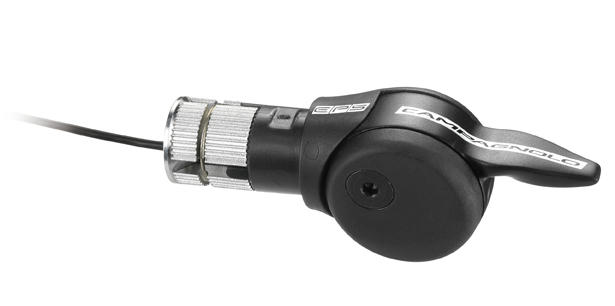
There is even an audible click with these levers, to make the shifting experience as mechanical-like as possible.
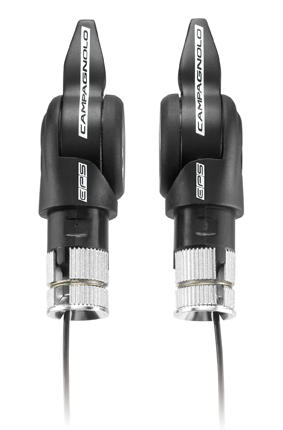
Separated buttons appear on the pursuit levers.
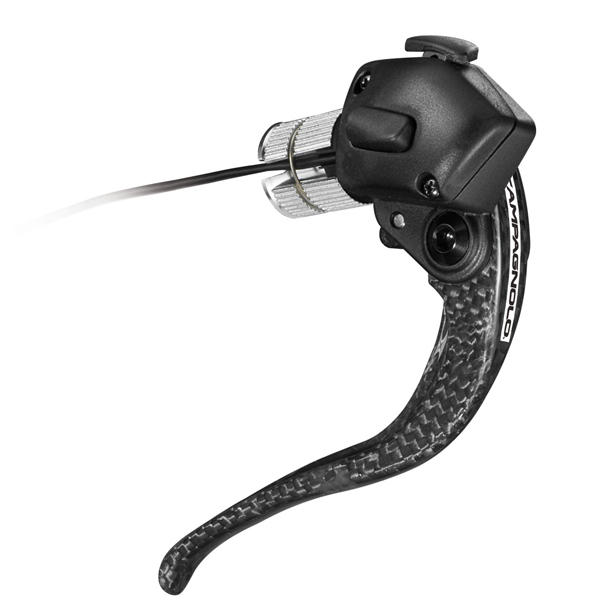
These pursuit levers continue the Campy tradition of allowing calipers to spread via the levers. This is very handy for Speed Concept riders.
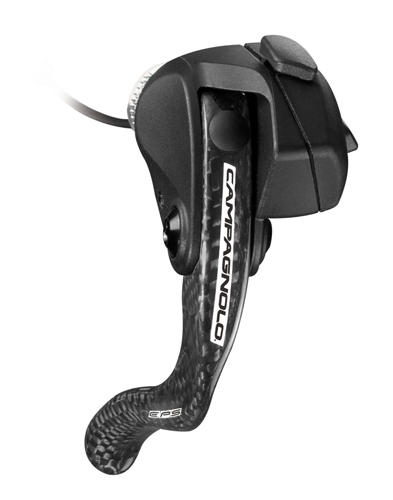
The "brain" controlling the shifting is removed entirely from the derailleurs, and all the "calculating" is done in the DTI unit, where the battery is housed.
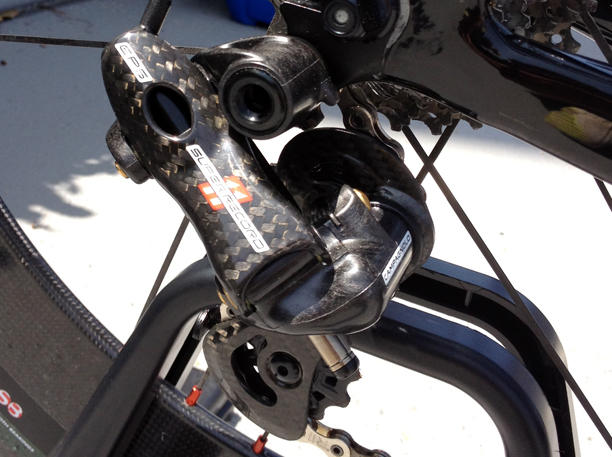
There are no limit screws on these derailleurs. Happily, you can adjust the system while riding, which will hopefully make certain there is no throwing of the chain off the rings.
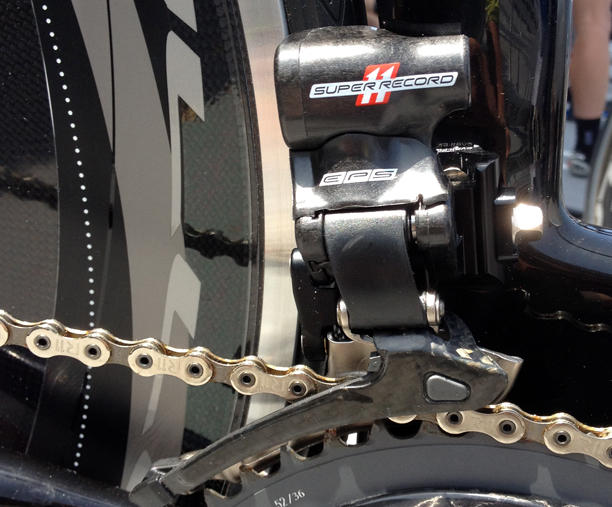
Both Shimano and Campy allow junctions to be mounted outside the bike, and the light-coded adjustment buttons enable the rider to tune the functionality of the system while aboard and riding, or when in the workstand.
